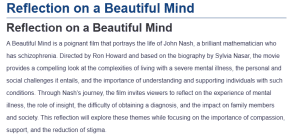Reflection on a Beautiful Mind
A Beautiful Mind is a poignant film that portrays the life of John Nash, a brilliant mathematician who has schizophrenia. Directed by Ron Howard and based on the biography by Sylvia Nasar, the movie provides a compelling look at the complexities of living with a severe mental illness, the personal and social challenges it entails, and the importance of understanding and supporting individuals with such conditions. Through Nash’s journey, the film invites viewers to reflect on the experience of mental illness, the role of insight, the difficulty of obtaining a diagnosis, and the impact on family members and society. This reflection will explore these themes while focusing on the importance of compassion, support, and the reduction of stigma.
Experiencing a Severe Mental Illness
One of the most striking aspects of A Beautiful Mind is its portrayal of what it feels like to experience schizophrenia. The movie provides a much-needed, crystal-clear vision of Nash’s hallucinations and paranoia and their gradual disintegration into his perception of reality. In his mind, these delusions are just as real as can be, be it his relationship with Charles or any other imagined person or his belief in a secret government plot. That is just how frightening and alienating severe mental illness can get. This disorientation, in which Nash is unable to distinguish reality from the products of his mind, is not only disorientating but emotionally overwhelming. For the person experiencing schizophrenia, reality comes across as fluid, unpredictable, and, most times, terrifying (Howard, 2001).

Insight and Diagnosis
One of the critical themes in the movie is the challenge of insight, or whether the mentally ill are capable of recognizing their condition. Nash’s journey in this film illustrates the common difficulty of people having insight into their disorder. Throughout the movie, Nash is unaware that he has schizophrenia. The problem is that his hallucinations and delusions are so real for him that he cannot believe these are symptoms of a mental illness and not reality.
This form of lack of insight is a common barrier with most people who have schizophrenia and other severe mental illnesses. It almost always delays treatment, as is the case with Nash. He is initially resistant to his illness, thinking instead that he is involved in top-secret government work. Even upon diagnosis, accepting that his mind is betraying him proves to be a monumental hurdle. This inability to cope with the diagnosis may also exacerbate the disorder, as the individual suffering from the disorder may refuse any form of treatment or adhere to prescribed therapies.
The diagnosis itself is not without issues, both at the personal and professional levels. Diagnoses of schizophrenia are generally subtle at the outset; hence, they are largely difficult to recognize. In Nash’s case, brilliance as a mathematician leads to confusion. His erratic behavior is passed off as eccentricity common among genius people. It is only when his delusions become too obvious to be overlooked that the severity of his condition is understood (Alyssa, 2021). Diagnosis of mental illness, especially the high-functioning cases like Nash’s, is difficult and therefore calls for wider awareness and understanding of psychiatric conditions.
Family and Social Responses
The second core theme of the movie is the effect of Nash’s illness on his family. Alicia, Nash’s wife, becomes a vital partner in helping to see him through the perils of his illness. She is portrayed as a strong, level-headed woman who stands by Nash when his actions become more and more bizarre and incomprehensible. Her love and devotion prove significant in Nash’s eventual development of symptom management techniques that enable him to regain some degree of normalcy.
However, Alicia’s experience also reflects the heavy burden that mental illness places on family members. It is draining to live with someone who has schizophrenia because one has to fight through the unpredictability of the illness, danger or erratic behavior, and emotional turmoil from seeing a loved one suffer. With Alicia’s struggle to keep her marriage intact and protect their son while taking care of Nash, the film represents all the various challenges caregivers have to go through. The movie epitomizes how mental illness is never a solo experience; it always affects one’s self and also the most intimate persons surrounding them.
Socially, Nash has to bear the cross of alienation from colleagues and friends as a result of his illness. The reason for this attitude toward him is the stigma attached to schizophrenia and other mental illnesses. The initial brilliance of Nash as a mathematician protects him against outright rejection by society, but marginalization becomes his lot as his illness aggravates. It reflects the greater challenge posed by society in its acceptance of the mentally ill individual for care and help. The sting of stigma attached to mental illnesses can often manifest in the form of a lack of help sought or received from within the community.
Dealing with Stigma
Self-stigma is one of the most challenging barriers for people with mental illness, something that Nash experiences in the movie A Beautiful Mind. Schizophrenia, in particular, is a mental disorder where one experiences the highest level of stigmatization due to the large amounts of misconceptions with which it is associated, and instead of guarantee, it only brings fear. It shows how Nash, a man previously respected in the academic environment, is reduced to a man about whom people can only gossip and look cognitively. His sickness puts a sort of insulation between him and reality, thus making him more withdrawn and hopeless.
Stigma is part of not only how others treat individuals with mental illness but also how those individuals view themselves. In the case of Nash, this will also heighten his fear of being seen as “crazy” or “broken,” compounding his difficulties in accepting diagnosis and treatment. Notably, when it comes to mental health conditions, internalized stigma can be common. This requires a cultural shift in perspective on mental illnesses: not to be feared or misunderstood, but empathized with and supported.
Barriers to Treatment
The movie also gives reasons why there are different barriers to care among mentally ill patients. In the case of Nash, the barriers include a lack of insight on his part, the stigma associated with his condition, and the shortcomings of the various treatments available to him at that time. The film is set at a time when treatments for schizophrenia are still at an experimental stage. The next scene lands Nash with insulin shock therapy, a brutal, for the most part, ineffective treatment (Subu et al., 2021). This is another example of how mental health is treated in the middle of the 20th century.
Even after his illness is diagnosed, Nash finds the side effects of medication deadening his intellect and resistant to continuing treatment. This is a common problem with mentally ill patients, who often must balance the benefits derived from treatment against their quality of life. This is a testament to the fact that the balancing act of managing symptoms while sustaining an enriching life may be extremely long and arduous, self-evidenced by Nash’s eventual decision later in his life to forgo medication in favor of other ways of coping.
References
Alyssa. (2021, March 30). Schizophrenia portrayed beautifully | Banyan Mental Health. Mental Health Program at Banyan Treatment Centers. https://www.banyanmentalhealth.com/blog/how-schizophrenia-was-portrayed-in-a-beautiful-mind/
Howard, R. (Director). (2001, December 21). A beautiful mind. Universal Pictures, DreamWorks Pictures, Imagine Entertainment.
National Institute of Mental Health. (2024). Schizophrenia. National Institute of Mental Health. https://www.nimh.nih.gov/health/topics/schizophrenia
Subu, M. A., Wati, D. F., Netrida, N., Priscilla, V., Dias, J. M., Abraham, M. S., Slewa-Younan, S., & Al-Yateem, N. (2021). Types of stigma experienced by patients with mental illness and mental health nurses in Indonesia: a qualitative content analysis. International Journal of Mental Health Systems, 15(77), 1–12. https://doi.org/10.1186/s13033-021-00502-x
ORDER A PLAGIARISM-FREE PAPER HERE
We’ll write everything from scratch
Question
Instructions
- Please select ONE Movie to watch and complete the Reflection Paper: “A Beautiful Mind”
- Please watch the movie and take some time to think about what it would be like to experience the disorder presented in the movie. Each student should write a 4 page typed, double-spaced reflection paper on their opinions, ideas and responses to the movie addressing the following questions:
- What it would be like to experience a severe mental illness?
- What are some common difficulties with insight (being aware of having a disorder and understanding it’s impact)?
- What is difficult about obtaining a diagnosis and understanding it?
- How do family members and other people respond to the illness?
- What is it like to deal with the stigma?
- What are common barriers to treatment?
APA Style is not necessary for this paper.
**Please do not provide a summary of the movie alone**

Reflection on a Beautiful Mind


